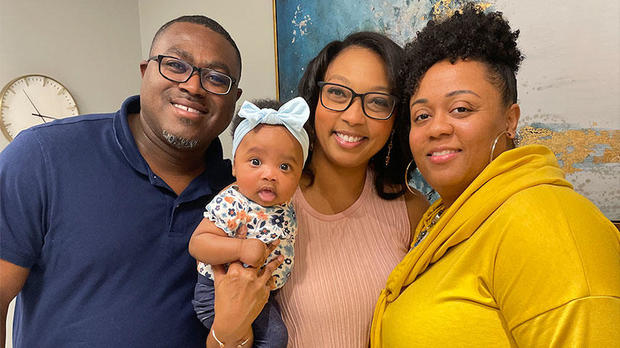
Ashley Burnett was 20 years old when she learned she had uterine fibroids after experiencing "crippling pain" that caused her to go to the emergency room.
After learning of her diagnosis, doctors performed two procedures: a myomectomy and a fibroid radiofrequency ablation, a procedure that uses heat to target fibroids one by one, reducing their size significantly.
In 2020, Burnett, who was expecting a baby boy with her husband learned the fibroids had returned, which ultimately caused her to lose her baby after going into labor at just 22 weeks.
"It's difficult for a fibroid and a baby to share the same space," Dr. Quanita Crable, a Texas Health OBGYN says. "That can cause a lot of miscarriages, early pregnancy loss. That can cause difficulty getting pregnant in the first place."
"To deliver a baby, to hear them cry, and to have to say goodbye to them four hours after is pretty difficult," Burnett shares.
Despite losing their son, Silas, Burnett and her husband still had hopes of growing their family so they turned to Dr. Crable, who performs myomectomies using the robotic-assisted da Vinci Surgical System, for help.
RELATED: Day 1: Just Been Diagnosed with Fibroids
A "miracle" baby
"I couldn't do anything about losing him at that point, but I wanted to make sure that going forward, I made the right decision for [my] body next," she says.
Although the minimally invasive robotic-assisted surgery is difficult to perform, it has a quicker recovery time than traditional methods, and it helps preserve uterine function, which can help the large number of women living with fibroids.
"About 70 to 80% of women have fibroids," says Dr. Crable. "And they're more common in African American women."
The procedure is also helpful for women hoping to conceive.
"I've seen a lot of women who are hopeless, crying in my office because they lost a baby or haven't been able to become pregnant," Dr. Crable adds. "Just the fact that I'm able to give them a little bit of hope, or a lot of hope, it's a feeling you can't even describe."
For Burnett, the surgery proved to be a success. Just seven months after she had the procedure, she got pregnant again. Although she was overjoyed, she was also understandably nervous.
"I was so nervous," the 37-year-old says. "I was scared. I was terrified. I was terrified the whole pregnancy."
Fortunately, Burnett was able to give birth to a healthy baby girl named Scarlett in September of 2022.
"...I'm holding this miracle that's in my hand, this blessing," Burnett shares. "Something I never thought I'd get."
RELATED: Living with Fibroids: Surgery Isn’t The Only Way To Stop Them
You are not alone
Burnett and Dr. Crable hope this story will inspire women with uterine fibroids to know they're not alone. An estimated 26 million girls and women between the ages of 15 and 50 have uterine fibroids in the United States, according to CBS Texas.
"There are so many women out there with Ashley's story, and I just want this to be in the forefront because I don't think people really realize how many women suffer with this or lose a baby with this," Dr. Crable notes adding that many women come to her for guidance after being told that a hysterectomy is their only option.
"26 fibroids later and one fallopian tube gone, I still conceived," Burnett adds. "So don't give up."
Pregnancy and fibroids
It is generally considered safe to get pregnant with fibroids. According to the American Society for Reproductive Medicine, fibroids are found in two to 12 percent of pregnant women. During pregnancy, fibroids tend to grow in size, according to USA Fibroid Centers. However, not all fibroids will get larger or cause problems. Fibroids typically grow during the first 12 weeks of the pregnancy, and most will shrink by the postpartum period.
Fibroids may also cause complications for you and your unborn child. Fibroids are associated with 10 percent of infertility cases and are the sole cause of infertility in up to three percent of patients, USA Fibroid Centers notes.
If you have fibroids and are considering getting pregnant, a fibroid specialist can give you an accurate diagnosis of the size and location of your fibroids using ultrasound guidance and help you determine the best treatment option as well as your next steps.









